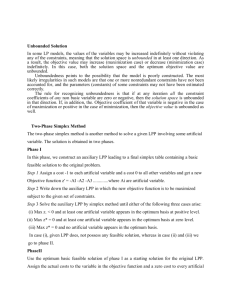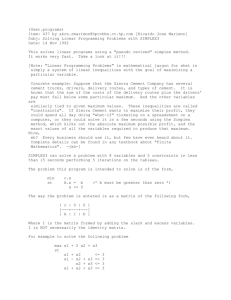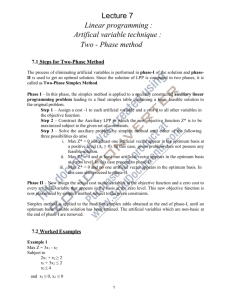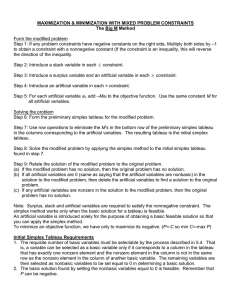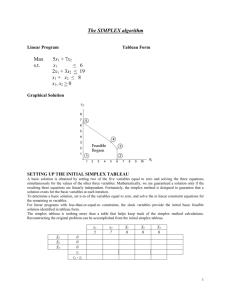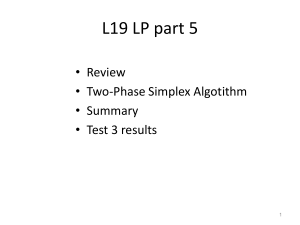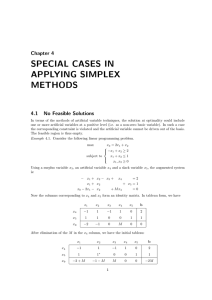Chapter 3
advertisement
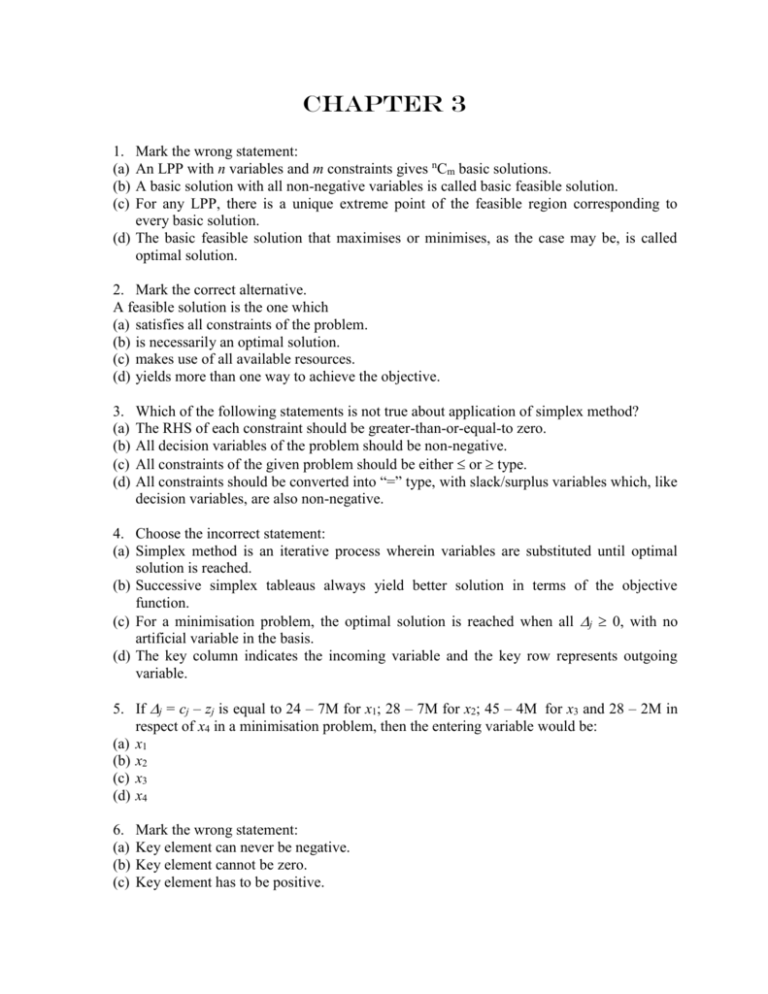
Chapter 3 1. (a) (b) (c) Mark the wrong statement: An LPP with n variables and m constraints gives nCm basic solutions. A basic solution with all non-negative variables is called basic feasible solution. For any LPP, there is a unique extreme point of the feasible region corresponding to every basic solution. (d) The basic feasible solution that maximises or minimises, as the case may be, is called optimal solution. 2. Mark the correct alternative. A feasible solution is the one which (a) satisfies all constraints of the problem. (b) is necessarily an optimal solution. (c) makes use of all available resources. (d) yields more than one way to achieve the objective. 3. (a) (b) (c) (d) Which of the following statements is not true about application of simplex method? The RHS of each constraint should be greater-than-or-equal-to zero. All decision variables of the problem should be non-negative. All constraints of the given problem should be either or type. All constraints should be converted into “=” type, with slack/surplus variables which, like decision variables, are also non-negative. 4. Choose the incorrect statement: (a) Simplex method is an iterative process wherein variables are substituted until optimal solution is reached. (b) Successive simplex tableaus always yield better solution in terms of the objective function. (c) For a minimisation problem, the optimal solution is reached when all j 0, with no artificial variable in the basis. (d) The key column indicates the incoming variable and the key row represents outgoing variable. 5. If j = cj – zj is equal to 24 – 7M for x1; 28 – 7M for x2; 45 – 4M for x3 and 28 – 2M in respect of x4 in a minimisation problem, then the entering variable would be: (a) x1 (b) x2 (c) x3 (d) x4 6. (a) (b) (c) Mark the wrong statement: Key element can never be negative. Key element cannot be zero. Key element has to be positive. (d) Key element can be negative, zero or positive. 7. The bi values and the elements in key column are (12, 0, 18, 6) and (-2, 8, 1, 3) respectively. Which of the rows will be selected as the key row? (a) First (b) Second (c) Third (d) Fourth 8. Which of the following statements is not true about artificial variables? (a) They are introduced when initial solution to a problem cannot be obtained for want of identity sub-matrix in the simplex tableau. (b) Each of such variables has to be assigned a very large negative co-efficient in the objective function when it is of the maximisation type. (c) They help to obtain an initial feasible solution to the problem. (d) They bear no tangible relationship with the decision problem. 9. (a) (b) (c) Which of these is not true? All basic variables in an LPP solution have j = 0. A slack variable cannot be there in the basis of optimal solution. If a problem has an optimal solution, the artificial variables, if any, introduced must be driven out of the basis one-by-one. (d) An outgoing variable in a simplex tableau cannot re-enter the basis in follow-up iterations. 10. Mark the wrong statement: (a) If a non-basic variable in the optimal solution to a problem has j = 0, it indicates multiple optimal solutions. (b) If an artificial variable is found in the basis of the final solution to an LPP, it implies feasibility. (c) A constraint with sign does not require artificial variable to be introduced. (d) A slack variable is used to convert ‘’ type and a surplus variable is used to convert ‘ ‘ type of constraint into equality. 11. Which of these is not correct? (a) The optimal solution to a maximisation LPP is unique if j values for all non-basic variables are less than zero. (b) If infeasibility is present, it is detected in phase II of the two-phase method. (c) In two-phase method, the artificial variables are each assigned a co-efficient of 1 in case of minimisation, and –1 in case of maximisation problems. (d) If the given problem has an optimal solution, the artificial variables are all removed one by one in phase I of the two-phase method. 12. Mark the wrong statement: (a) If there are no non-negative replacement ratios in a simplex tableau, then unboundedness is indicated. (b) In a tableau, the key column elements are –5, 0, 0, 7 while the corresponding bi values are 20, 6, 8 and 0. This indicates unbounded solution. (c) A tie in the minimum replacement ratio implies that the next solution would be degenerate. (d) It is possible for the initial solution to an LP to be degenerate. 13. If there is no non-negative replacement ratio in a solution which is sought to be improved, then the solution is indicated to be (a) infeasible. (b) unbounded. (c) degenerate. (d) unique optimal. 14. Which of the following is not correct? (a) As and when a degenerate variable is outgoing, no change will take place in the objective function value. (b) Degeneracy may be a temporary phenomenon. (c) It is possible for the repetition of same tableau in the course of successive iterations when degeneracy is encountered. (d) A degenerate solution cannot be optimal. 15. Degeneracy in LPP (1) renders the solution infeasible, (2) leads to multiple optimal solutions, (3) increases computations without affecting the solution as long as the outgoing variable happens to be degenerate. Which of these statements is/are correct? a) 1, 2 and 3 b) 1 and 3 c) 2 and 3 d) 3 only
